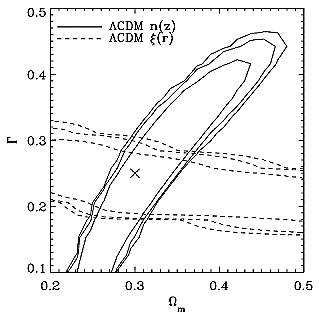 |
 |
|---|
Index - ... - The survey characteristics - Scientific Goals - Simulations (1/3) - ...
 |
 |
|---|
The unrivaled sensitivity and good point-spread function of XMM will open a new era for X-ray large-scale structure studies.
Some 1000 times more sensitive than the REFLEX survey - the largest cluster survey over a single area to date (Böhringer et al 2001) - the XMM-LSS survey is designed to probe the large scale distribution of clusters of galaxies out to z ~ 1 and of QSOs much further out. This will provide unprecedented insight onto LSS formation and, thus, cosmology. We will be able to probe the nature and amount of dark matter, the initial fluctuation spectrum and other fundamental cosmological parameters.
 cosmo1.eps.gz (gzipped Postscript, 6150 bytes) |
 cosmo2.eps.gz (gzipped Postscript, 5274 bytes) |
Constraints upon the cosmological parameters
 m and m and
 8 (the amplitude of mass
fluctuations on 8 h-1 Mpc scale) for a 8 (the amplitude of mass
fluctuations on 8 h-1 Mpc scale) for a
 CDM universe. Cluster abundance data
provides strong constraints upon the CDM universe. Cluster abundance data
provides strong constraints upon the
 m - m -
 8 combination. 8 combination.
|
Constraints upon the cosmological parameters
 m and m and
 (the shape of the power spectrum)
for a (the shape of the power spectrum)
for a  CDM universe.
The correlation function is a powerful tool to constrain the shape of
the initial spectrum. CDM universe.
The correlation function is a powerful tool to constrain the shape of
the initial spectrum.
|
|
Solid lines: XMM-LSS cluster counts - Dashed lines: correlation function.
In each case, the 68%, 90% and 95% confidence level contours are shown along with the assumed model (cross). These calculations have been performed assuming that only the redshifts over the [0<z<1] x [64 deg2] volume are available. (Predictions from Refregier et al., 2001.) |
|
In addition, identification of a "Coma-type" cluster within the XMM-LSS
over the redshift range 1.5 < z < 2 has a probability of
~ 6.5 10-7 in the current  CDM
scenario. Therefore, any such discoveries in the survey would put
the currently favoured cosmological model in great observational difficulty.
CDM
scenario. Therefore, any such discoveries in the survey would put
the currently favoured cosmological model in great observational difficulty.
The primary science goals are: